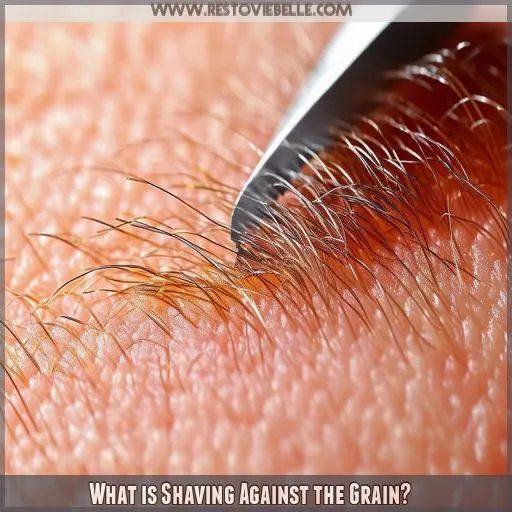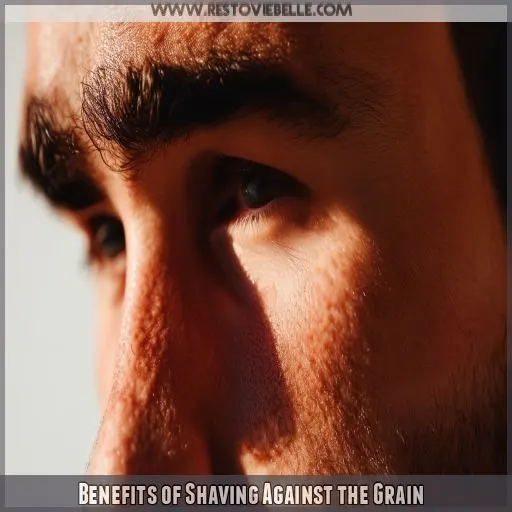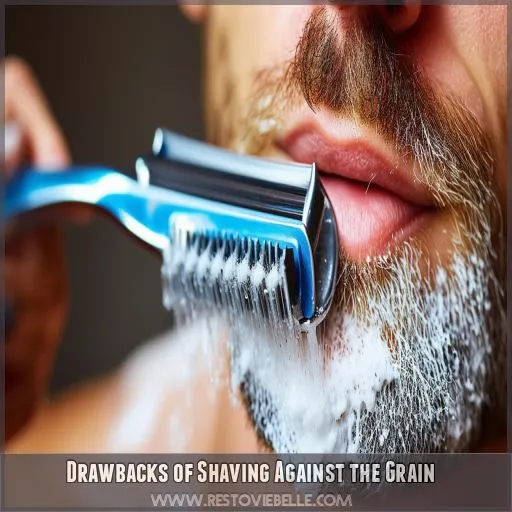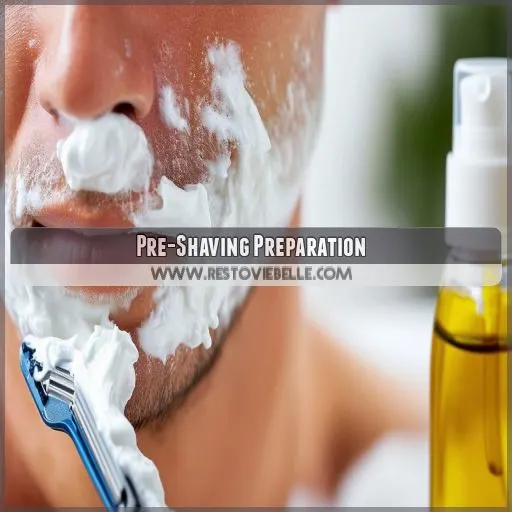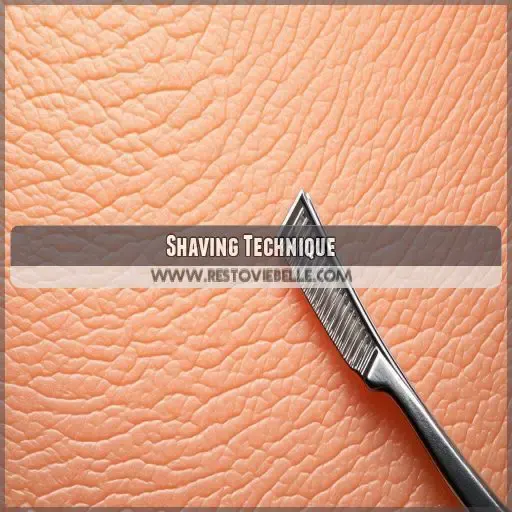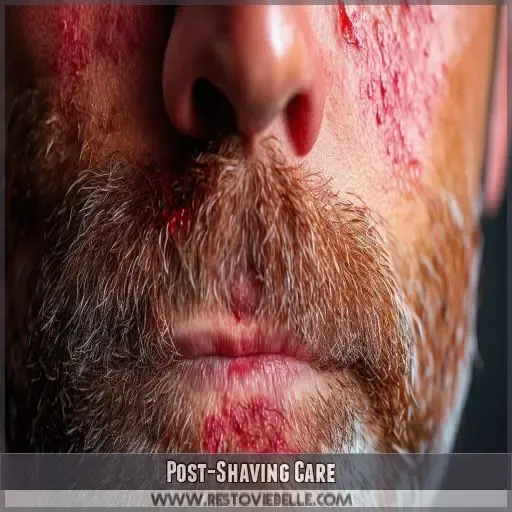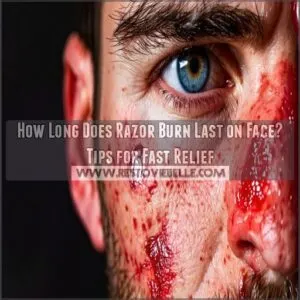This site is supported by our readers. We may earn a commission, at no cost to you, if you purchase through links.
 Shaving against the grain seems to give a smoother and closer shave, although it increases irritation, razor bumps, and ingrown hairs. Be informed about the benefits versus drawbacks of this method and how to do it best.
Shaving against the grain seems to give a smoother and closer shave, although it increases irritation, razor bumps, and ingrown hairs. Be informed about the benefits versus drawbacks of this method and how to do it best.
Our guide includes expert tips, pre-shaving preparation, and post-shaving care that will help you master that smooth shave with minimal risks. This comprehensive approach ensures you get a clean shave while maintaining healthy skin.
Here’s everything you need to know about shaving against the grain
Table Of Contents
- Key Takeaways
- Can I Shave Against the Grain?
- What is Shaving Against the Grain?
- Benefits of Shaving Against the Grain
- Drawbacks of Shaving Against the Grain
- Pre-Shaving Preparation
- Shaving Technique
- Post-Shaving Care
- Frequently Asked Questions (FAQs)
- Is it bad to shave against the grain?
- Is it okay to shave upwards?
- Does shaving against the grain damage hair follicles?
- Should I shave my legs with or against the grain?
- Can You shave against the grain?
- What is shaving against the grain (ATG)?
- What does shaving across the grain mean?
- Should you shave against the grain if you have curly hair?
- How to handle razor bumps after shaving?
- Can shaving against the grain cause infections?
- Is there a specific razor type recommended?
- What are alternative shaving techniques?
- How often should I replace my razor blade?
- Conclusion
Key Takeaways
- Shaving against the grain can give you a closer shave, but it’s not for everyone. If you have sensitive skin or are prone to razor burn, stick to shaving with the grain.
- If you do decide to shave against the grain, be sure to use a sharp razor and take your time. Don’t press too hard, and be sure to rinse your razor frequently.
- After shaving, be sure to moisturize your skin to help prevent irritation.
- If you experience any irritation or razor burn, stop shaving against the grain and consult with a dermatologist
Can I Shave Against the Grain?
Yes, you can shave against the grain, but be very careful. It gives a closer shave and lessens the frequency, however, it will provide people with coarse or curly hair irritation, razor burn, and ingrown hairs.
Before you start, determine your hair growth direction by feeling it with your fingers and hydrate the skin with warm water. Use quality shaving gel. Always shave with the grain first, across the second, and lastly, against. Use light, gentle strokes.
What makes a difference in avoiding nicks and cuts is the proper technique tempered with patience. Abide a bit longer to get more tips from experts on how to shave smooth and irritation-free
What is Shaving Against the Grain?
Shaving against the grain simply means shaving in the opposite direction of hair growth. This is a technique used to attain a closer shave; however, much of the time, people are worried about irritation and razor burn.
You can determine your hair growth pattern by stroking your hand or swiping a credit card across your face; if there’s some resistance, you’re going against the grain.
While the method provides a smoother finish, it takes a heavy toll on sensitive skin. Proper preparation and techniques are to be followed so that irritation and razor burns could be avoided.
Keep in mind always to close with cold water after shave and apply a soothing aftershave balm for the best post-shave care
Benefits of Shaving Against the Grain
Shaving against the grain can give you a closer shave and help reduce how often you need to shave. However, it’s important to address the risk of irritation to achieve the best results
Achieving Closer Shave
Shaving against the grain achieves a close shave by lifting hair follicles, allowing a smoother finish. However, this method can increase skin irritation and razor burn, especially with coarse or curly hair. Use quality shave gel and a sharp razor
Reducing Shaving Frequency
Shaving against the grain reduces shaving frequency because it cuts hair closer to the skin, resulting in slower hair regrowth. This technique is especially beneficial for those with coarse hair, providing longer-lasting smoothness when done correctly
Addressing Irritation Risks
To address irritation risks, choose shaving products designed for sensitive skin. Use a sharp razor and a proper shaving method, including aftershave care like applying an after-shave moisturizer. This helps prevent razor burn, ingrown hairs, and inflammation
Drawbacks of Shaving Against the Grain
While shaving against the grain offers a closer shave and less frequent need for shaving, it has drawbacks. It often causes razor burn, leading to uncomfortable, red, irritated skin. You might also experience skin irritation due to ingrown hairs. This can be particularly problematic:
- Unskilled technique: Beginners find it hard, often resulting in nicks and cuts.
- Coarse or curly hair: Shaving against the grain with these hair types increases the risk of irritation and ingrown hairs.
- Sensitive skin: If your skin is prone to irritation, shaving against the grain might exacerbate problems.
Use caution with this shaving technique to avoid these issues
Pre-Shaving Preparation
Before you shave against the grain, it’s important to properly prepare your skin to minimize irritation. Start by determining your hair growth direction, then hydrate your skin and apply a premium shave gel to soften the hair and protect your skin
Determining Hair Growth Direction
To determine hair growth direction, simply rub your hand or a credit card across your face. Resistance indicates the direction against the grain. Key tips:
- Assess grain direction
- Identify hair resistance
- Map hair growth pattern
- Account for skin sensitivity
Hydrating Skin
Always keep your skin well-hydrated before shaving. Warm water—ideally while in a steamy shower for a few minutes—softens the hairs and lessens the shaving force. Bring out the best in your routine by using these hydration techniques:
- Shower Duration
• Moisturizing benefits
- Skin preparation methods
Applying Shave Gel
Ensure great shaving ease and reduced irritation with a quality shave gel. Softens hair and helps protect from nicks.
- Improves shave gel performance
Perfect for coarse hair and men’s facial hair.
- Reapply before shaving against the grain
Shaving Technique
The proper technique would be to shave with the grain, across the grain, and then finally against it if needed. Each is very carefully done, using light, gentle strokes, and reapplying shaving gel to minimize razor burn and ensure a close shave.
Shave With the Grain
Begin by shaving with the grain using gentle, light strokes. This pass method reduces razor burn, minimizes skin irritation, and is easier for beginners to achieve a smooth shave
Shave Across the Grain
To shave across the grain, use a sharp razor and light strokes. This technique reduces shaving duration and frequency, while minimizing skin sensitivity and irritation. Adjust shaving angles accordingly
Shave Against the Grain
Shaving against the grain requires a steady hand and patience. To minimize irritation and ingrown hairs, ensure:
- Proper razor selection
- Light, gentle strokes
- Reapply shave gel frequently
Shaving
Shaving against the grain can be intimidating for beginners. Start with these steps:
- Shave with the grain first
- Use gentle strokes
- Reapply shave gel before going against the grain
Post-Shaving Care
Next comes the after-shave care. Begin with a rinse: cool, refreshing water will help alleviate irritation.
Be gentle when drying your face using only a soft, clean towel—no harsh rubbing allowed.
Finally, use a soothing aftershave balm or moisturizer to replenish and nourish your skin. Look for creams that comprise aloe vera, vitamin E, or shea butter to lessen redness or discomfort.
Last but not least, avoid any activity that may cause further irritation to your skin, including too much exposure to the sun and strenuous exercise, right until your skin completes its recovery process.
Frequently Asked Questions (FAQs)
Is it bad to shave against the grain?
Shaving against the grain can provide a closer shave, but it also increases the risk of irritation, razor burn, and ingrown hairs. It’s best to start with the grain and only go against it if necessary
Is it okay to shave upwards?
Yes, you can shave upwards, but be cautious. Shaving against the grain gives a closer shave but increases the risk of irritation, razor burn, and cuts. Proper preparation and technique are essential for a smooth experience
Does shaving against the grain damage hair follicles?
Shaving against the grain doesn’t directly damage hair follicles, but it can cause irritation and razor burn. In fact, 60% of men report skin irritation when shaving against the grain, so approach it carefully to avoid discomfort
Should I shave my legs with or against the grain?
For a smoother result, shave against the grain on your legs, but only after initially shaving with the grain. Be cautious to avoid irritation and always use a sharp razor and proper pre- and post-care
Can You shave against the grain?
Yes, you can shave against the grain for a closer shave. However, it’s equally essential to properly prepare the skin for shaving and, use light strokes a sharp razor, and that the proper aftercare with moisturizing is carried out.
What is shaving against the grain (ATG)?
Shaving against the grain means shaving in the opposite direction of your hair growth. It provides a closer shave but can lead to irritation, razor burn, and isn’t recommended for beginners or those with sensitive skin
What does shaving across the grain mean?
Shaving across the grain means shaving perpendicular to the direction of hair growth. You glide the razor sideways, which can help reduce irritation while providing a closer shave than shaving with the grain alone
Should you shave against the grain if you have curly hair?
If you have curly hair, shaving against the grain can increase the risk of ingrown hairs and irritation. It’s generally better to stick to shaving with the grain or use extra caution if shaving against it
How to handle razor bumps after shaving?
Nip razor bumps in the bud by rinsing with cold water, patting dry, and applying a soothing aftershave balm. Avoid shaving over irritated areas and consider using a gentle exfoliant to prevent future bumps from forming
Can shaving against the grain cause infections?
Shaving against the direction of hair growth causes potential micro-tears and irritation that could offer entry sites for bacteria. To minimize risk, ensure proper technique, hygiene, and aftercare, like moisturizing and applying aftershave balm.
Is there a specific razor type recommended?
For shaving against the grain, use a razor designed for sensitive skin. Look for one with multiple blades, a pivoting head, and a moisturizing strip to reduce irritation and achieve a close, comfortable shave
What are alternative shaving techniques?
You can try alternative techniques like dry shaving with an electric razor, which reduces irritation, or wet shaving with cream and a single-direction pass to minimize skin issues. Always moisturize afterward for best results
How often should I replace my razor blade?
Replace your razor blade after 5-7 uses. This means that if you shave every day, change the blades once a week. This will help prevent the blade from getting too dull and reduce irritation. A clean and efficient shave should minimize nicks and cuts.
Conclusion
Interestingly, nearly 60% of men claim that they experience skin irritation when shaving against the grain.
If you’re wondering, "Can I shave against the grain?" the answer is yes, but be careful. Proper preparation and technique minimize risks.
Keep your skin moist, lather with some shaving cream, follow a structured shave path, and treat your skin after a shave.

